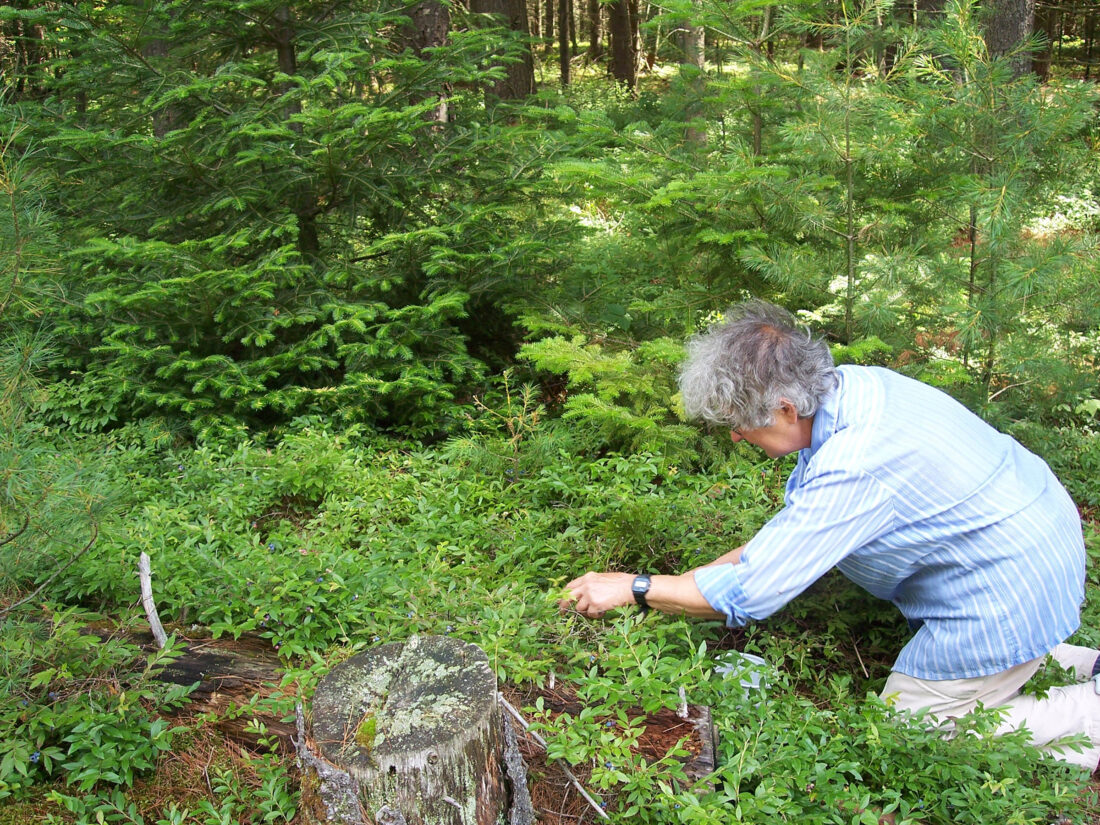Another Super-berry: The Blueberry

Picking berries (Provided photo — Yvona Fast)
Woodland clearings are full of low bushes loaded with berries, abundant and free for the picking. Area berry farms (like those in AuSable Forks and Peru, New York) have high bush berries for those who want to purchase them or pick their own without bending so low. Delicious, satisfying, wholesome blueberries are abundant right now — so go out and enjoy the harvest!
Our wild Adirondack “lowbush” blueberries, V. angustifolium, are cold-hardy native plants that grow wild in sandy, well-irrigated acidic soils as far north as the Arctic, typically reaching heights of 1 to 2 feet. The berries are smaller than the highbush variety, but will produce up to 4,000 pounds of berries per acre. Robert McCloskey’s children’s book, Blueberries for Sal, popularized Maine lowbush berries. Indeed, Maine accounts for more than half of the wild blueberry crop, but they’re also common in eastern Canada, Vermont, New Hampshire and of course, the Adirondacks. Black bears love them and have been known to travel ten or more miles in search of a blueberry patch. No wonder — the berries’ tangy-sweet flavor is more intense than the high-bush cultivated varieties.
Native Americans dried blueberries for winter use, combining them with cornmeal and honey to make a pudding called “Sautauthig,” and used them in the smoked meat dish pemmican. They used berries to make dye, brewed a tea from the leaves and used both leaves and roots for medicinal purposes.
The high-bush blueberry grows wild in North American woods that are slightly warmer than ours. It is also cultivated on farms in Oregon, Washington, New Jersey and Pennsylvania, among others (but those are where most of our commercial blueberries are sourced).
Today, we know that blueberries are a nutritional powerhouse. They’re good sources of fiber and vitamin C and contain vitamin A, calcium, iron, potassium and magnesium. They’re also higher in antioxidants, flavonoids, anthocyanins, pterostilbene, ellagic acid and other powerful nutrients than most other fruits and veggies. Anthocyanin, the pigment that makes blueberries blue, is believed to be the source of many of the blueberry’s important antioxidants. However, processed foods (like bread, cereals and baby foods) containing berries do not contain anthocyanins, according to a study in the Journal of Agricultural and Food Chemistry.
Medical studies suggest that eating lots of blueberries may help lessen brain damage from strokes and may reduce the effects of Alzheimer’s disease or dementia. Other studies suggest that blueberries can help strengthen eyesight, helping prevent glaucoma, cataracts and macular degeneration.
Berries are best eaten fresh. No matter how you serve them, blueberries are amazing morsels of sweet, fruity flavor that burst in your mouth.
Top them with whipped cream or vanilla ice cream. Mix with yogurt or cottage cheese. Add them to breakfast cereal; mix into a smoothie; add to salads, sauces and salsas. They’re popular in baked treats like cobblers, pies, tarts, scones, biscuits, muffins and sweetbreads. And who doesn’t love blueberry pancakes?
Blueberries aren’t just for dessert. You can incorporate them into soups, salads, main dishes. Condiments, like ketchup, barbecue sauce, salsa or chutney can be made with berries in place of tomatoes. For a beverage, try a blueberry smoothie, mojito or margarita. The blue bombshells are versatile and will easily take center stage at any summer gathering.
Blueberries keep well in the freezer. To keep them separate, freeze on cookie sheets in a single layer for about 30 minutes, then transfer to storage containers.
–
Blueberry Banana Smoothie
–
Ingredients:
–
1 cup yogurt (plain, vanilla or blueberry)
2 cups blueberries (frozen if possible)
1 banana
1/3 cup crushed ice
–
Directions:
–
Place yogurt, berries and chunks of banana in the blender. Blend until frothy. Add ice and blend a few more seconds.
If desired, substitute another berry for blueberries.
–
Greens and Berries Salad
–
Ingredients:
–
Vinaigrette:
–
2 Tablespoons extra virgin olive oil
Juice of 1/2 lemon (2 tablespoons)
1 Tablespoon orange juice
1 teaspoon mustard
1/4 teaspoon salt
1 teaspoon honey
–
Salad:
–
1/2 lb arugula
1/2 lb lettuce
8 oz. cooked chicken, salmon, trout, etc.
2 to 3 scallions, white and green parts
1 cup blueberries
1/2 cup red or black currants
2 Tablespoons crumbled feta or goat cheese
–
Directions:
–
Wash greens. Use a salad spinner to dry or drain well and pat dry.
In a salad bowl, combine dressing ingredients and stir with a fork. Toss in chicken or fish to coat. Toss in greens and scallions and mix to combine. Stir in berries. Garnish with cheese.
— — —
Author of the award-winning cookbook Garden Gourmet: Fresh & Fabulous Meals from your Garden, CSA or Farmers’ Market, Yvona Fast lives in Lake Clear and has two passions: writing and cooking. She can be found at www.yvonafast.com and reached at yvonawrite@yahoo.com or on Twitter: @yvonawrites.



